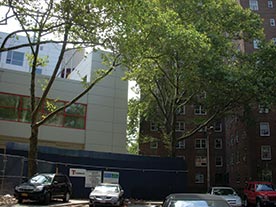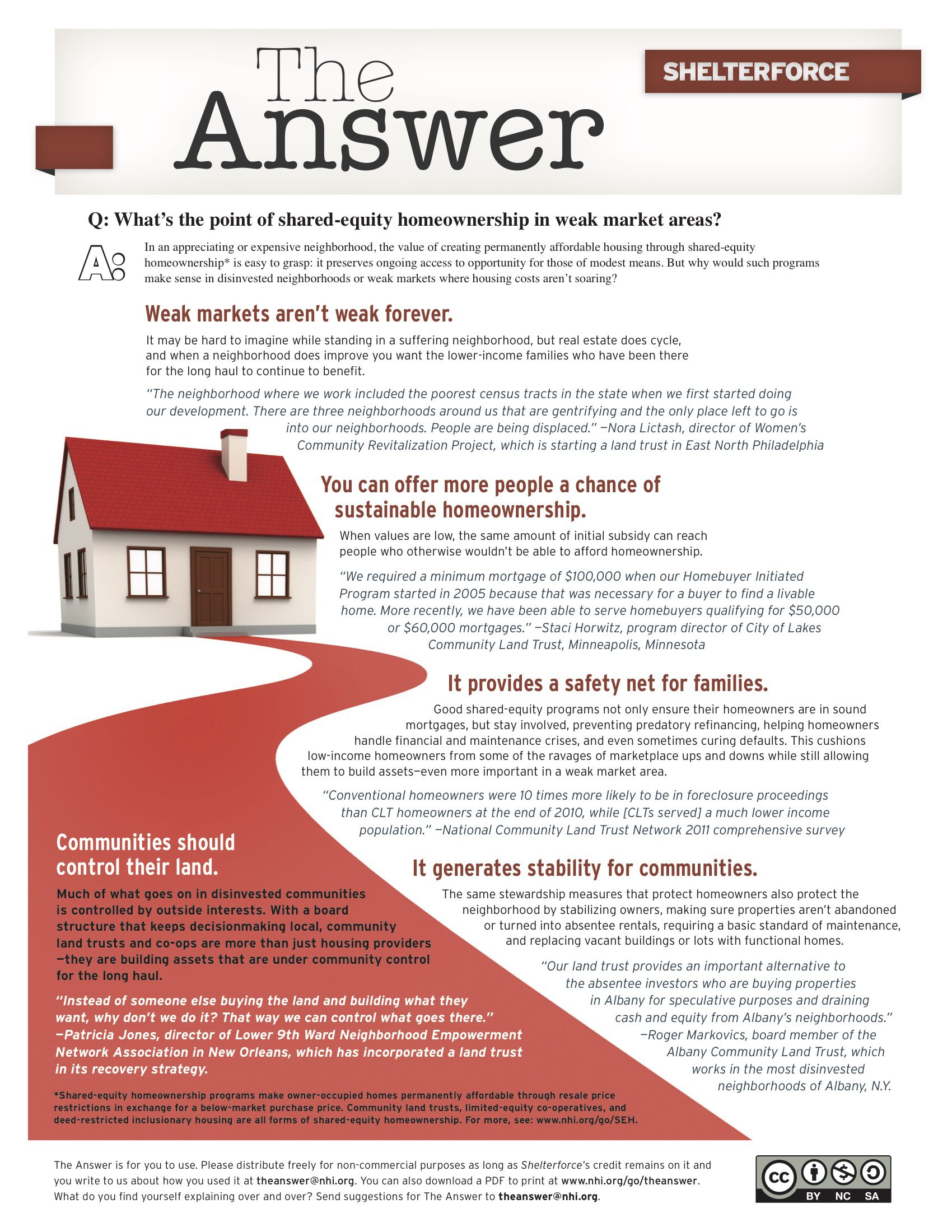
Harlem Children’s new Promise Academy, abutting one of the buildings in the St. Nicholas Houses. Photo by Alexis Stephens
Two new charter schools are sprouting in Upper Manhattan on the grassy campuses of some of New York City’s classic public housing developments. And they are not likely to be the last developments moving in on these formerly open spaces.
The New York City Housing Authority (NYCHA), which is in charge of the largest stock of the city’s publicly owned land, has initiated a plan to sell the development rights to what it calls “unused,” “underutilized,” or “vacant” land situated within its housing superblocks. NYCHA argues that the revenues from these sales outweigh the quality of life concerns that have been raised by residents and advocacy organizations.
Manhattan Borough President Scott Stringer proposed this strategy in Land Rich, Pocket Poor: Making the Most of New York City Housing Authority’s (NYCHA) Unused Development Rights, a 2008 paper in which he advises NYCHA to develop a long-term plan for its “property surplus” by redeveloping it as rental housing, for-sale housing, retail, schools, or offices. Stringer says the revenue could be funneled into the upkeep of existing public housing.
The report suggests that these projects be pursued as “as-of-right developments,” which would prevent them from being subject to the city’s standard land use review process. NYCHA would still be required to “consult” with tenant associations, but the document brushes off the idea that these real estate developments would have an effect on them:
“While the sale of unused development rights is of understandable and legitimate interest to NYCHA residents, it is important to note that selling unused development rights would not affect the public nature or affordability requirements of existing housing … [it] would not impact the status of current residents in any way.”
The language of this passage is very specific: this piecemeal selling of land would not affect residents’ status. There is no reference to how it would affect the livability of their surroundings.
In a presentation to the National Housing & Rehabilitation Association in February 2011, NYCHA Chair John Rhea admitted there are challenges with development rights transfers. He said maximizing the development potential of sites may produce buildings significantly out of scale with the surrounding neighborhood. In some cases, he added, the development would result in displacement of open space, including passive and active recreation used by NYCHA residents and their neighbors. Rhea said these considerations are balanced by the fact that the “monies obtained for this property will be reinvested to preserve existing housing” and that “new development can provide triple bottom line benefits: revenue to NYCHA, community benefits and sustainable development.” However, whether these developments should actually be considered “sustainable” is a matter of considerable controversy.
Under Construction
The two charter schools under construction on public housing grounds are both in upper Manhattan: a branch of Harlem Children’s Zone Promise Academies within Central Harlem’s St. Nicholas Houses and the youth development organization Harlem RBI’s DREAM Charter School within East Harlem’s President George Washington Houses.
Supporters point out the benefits of the schools’ ambitious educational programming, the formation of “public housing neighborhoods,” and job creation. At the groundbreaking for the DREAM Charter School building, which also contains spaces for Harlem RBI’s offices and affordable housing units, Rhea commented, “We are here today because we are focused on students, NYCHA residents, and their families and to show our continued involvement in building the neighborhoods that will serve East Harlem families’ needs in the 21st century.”
But opponents have argued that the park, gardens, playgrounds, and benches that are being torn down to make space for these new amenities are also essential to the community’s wellness — they provide much needed ventilation, recreation, and gathering spaces. They have also voiced concerns that the schools present new safety, overcrowding, and traffic concerns. In both cases, residents have said they were not sufficiently consulted in the planning and implementation processes.
Patricia Jackson, 58, who lives across the street from the St. Nicholas Houses, does not remember any public consultation process before the construction of the Promise Academy, which is nearing completion. “No one told us,” she says. “There was no meeting to ask the community what we thought.”
NYCHA’s press releases indicate that there was in fact community outreach at St. Nick’s in the form of dozens of meetings with the tenant association, community board, and local elected officials, but there is nonetheless a feeling of exasperation on the ground. Another resident, who did not wish to be identified, says, “If there had been more community involvement in the decision-making process, they might have decided that it’s OK. I have nothing against the building of a school. But I’m not sure that this location is an ideal location. And a lot of people share the same sentiments.”
In the book Restorative Commons: Creating Health and Well-Being Through Urban Landscapes, published in 2009 (pre-dating the construction of the charter school), there is a short article on NYCHA’s “Garden and Greening Program” that singles out programs slated to take root at the St. Nicholas Houses as examples of the program’s success. It cites the creation of a one-mile walking path around the grounds and additional gardens and trees around the perimeter, providing residents with “exercise, activity, and a source of relaxation and pride. For those who simply see the gardens or walk by them, [gardens] provide visual interest, and reduce the amount of garbage dumped: even less mobile residents can benefit from looking out their windows.” The unified campus, the benefits of which were touted by the article, has now been bisected by the new Promise Academy.
At the Washington Houses, the most pressing issue that emerged after the plans for the school were revealed was the elimination of a popular communal space to accommodate the relocation of six trash compactors. The gathering space had been used for summer barbecues and picnics, birthday parties, and informal get-togethers for families and seniors.
Along with the loss of communal space, concerns about rodents and air quality in a high-asthma area mobilized Washington Houses residents to action. They contacted the advocacy group Community Voices Heard (CVH), which held multiple press conferences and rallies over the issue. Kflu Kflu, public housing field coordinator for CVH explains:
“We initially supported the school being built. We need more affordable housing and we need more schools. What made this issue problematic was that the decision was made top-down. When [NYCHA Board member] Margarita López came to speak to us, she, in a condescending and patronizing way, told the residents what was happening and what was best for them. And then it was kind of ‘hush hush.’ It was a done deal and then all of a sudden there was a start and end date. Mind you, they are taking someone’s public space — what little space they have — and putting in garbage compactors.”
A coalition of community members at the Washington Houses met with NYCHA in May 2012 to negotiate the issue of the trash compactors. At the meeting, they were promised a comprehensive rodent management plan for the area, a reduction from six to three compactors and an extra wall of protection around them, a new barbecue/picnic station in another location, and fast-tracked repairs for the complex. Kflu considers being at the table to be progress at the minimum: “We didn’t completely win, but we were able to get them moving on some things and we got people motivated and organized.”
Two of the tenant organizations opposing NYCHA on these buildings, Citizens for the Preservation of St. Nicholas Houses and East Harlem Preservation (Washington Houses), say they are fighting not only for the preservation of physical space, but also for the quality of life, character of place, and culture of these sites. Another group, a coalition of public housing advocacy organizations called the NYC Alliance to Preserve Public Housing, has expressed deep concerns about the “privatization” of public housing resources through projects like this.
NYCHA, Harlem Children’s Zone, and Harlem RBI declined to comment for this article.
Parks But Not Quite
The Washington Houses and St. Nicholas Houses are both located in areas that are underserved in terms of open space, according to the NYC Office of Environmental Coordination, falling well below New York City’s already low average of 2.5 acres of open space per 1,000 residents. (Also, much of the open space that is counted in New York City is concentrated in areas like Central Park that are underutilized by low-income residents and communities of color.) NYCHA is in charge of 26,000 acres of open space, a precious resource in such an environment.
In 2011 a group of tenants filed a lawsuit against NYCHA, the federal Department of Housing and Urban Development, and Harlem Children’s Zone claiming, among other things, that they should have sought permission from the city council and state legislature before taking away open space for the Promise Academy. The suits rely on New York state laws on the “alienation and conversion of municipal parkland.”
But there are fuzzier protections for public housing campuses than there are for formal parks that fall under the jurisdiction of the New York City Parks Department. This is true despite the fact that many were created in concert with one another, and for the same reasons, in a time of great public investment in the 1930s and 1940s. Nicholas Dagen Bloom, in his book Public Housing That Worked, explains why: Robert Moses, parks commissioner at the time, chose to not define open spaces in public housing as parks to protect his budget and authority. He described NYCHA grounds as “landscaping,” not parks, because he felt they were “no substitute for properly operated independent playgrounds under the Parks Department.”
Urban thinker Jane Jacobs argued that these spaces were barren, unfriendly zones in contrast to her preferred low-rise urban villages. But in Restorative Commons, Rob Bennaton, head of NYCHA’s “Garden and Greening Program,” says that use of that open space for gardening and greening can help with “anything from drug rehabilitation to relief from stress,” slow and steady exercise for seniors, fresh foods and snacks, opportunities to build cultural connections, and a “nonconfrontational way to reclaim the land for productive and positive use.”
Historic preservation might be a possible tactic to protect these open spaces. NYCHA relies on federal funding, and any potentially historically significant properties would be subject to review under Section 106 of the National Historic Preservation Act, with NYCHA publicly accountable for adverse actions to them, including to key features of the “landscaping.” NYCHA has begun working with the New York State Office of Parks, Recreation & Historic Preservation (SHPO) to create an inventory of gardens, buildings, and facilities on public housing properties that are more than 50 years old and could have the potential for landmarking. Kathy Howe, a historic preservation specialist with the SHPO, says that open space is crucial to the integrity of public housing campuses, and that “landscape plays a huge role in what would make them significant and help them to become eligible [for the National Register of Historic Places].” Two public housing developments that she mentioned, the Amsterdam Houses on the Upper West Side and Eastchester Gardens in the Bronx, are considered eligible for the register based on having the same qualities of modern urban design as many other public housing campuses in the city: central axis plans, semi-circular play spaces, curved walkways, and harmonious building siting.
With the two school developments, NYCHA is starting down a path of promoting these open spaces as being more valuable as commodities than as environmental and cultural assets. Given what residents and other stakeholders are saying about how they value their gathering spaces, a holistic approach to the creation of “public housing neighborhoods” should be required to take into account the benefits of open space as well.





Comments